Tesco: Analyzing Business Environment, Structure, and Operations
VerifiedAdded on 2024/05/20
|28
|5521
|451
Report
AI Summary
This report provides a comprehensive analysis of Tesco's business environment, examining various organizational types, sizes, and scopes, including public, private, and voluntary sectors. It explores the interrelationship of organizational functions and their link to the organizational structure, using Tesco as a case study. The report identifies the positive and negative impacts of the macro environment on Tesco's operations, supported by PESTLE analysis. Furthermore, it conducts internal and external analyses to identify Tesco's strengths and weaknesses, interrelating them with external macro factors through SWOT/TOWS analysis, and critically evaluates the impacts of both macro and micro factors on business objectives and decision-making. This document is contributed by a student and available on Desklib, a platform offering AI-based study tools and resources.
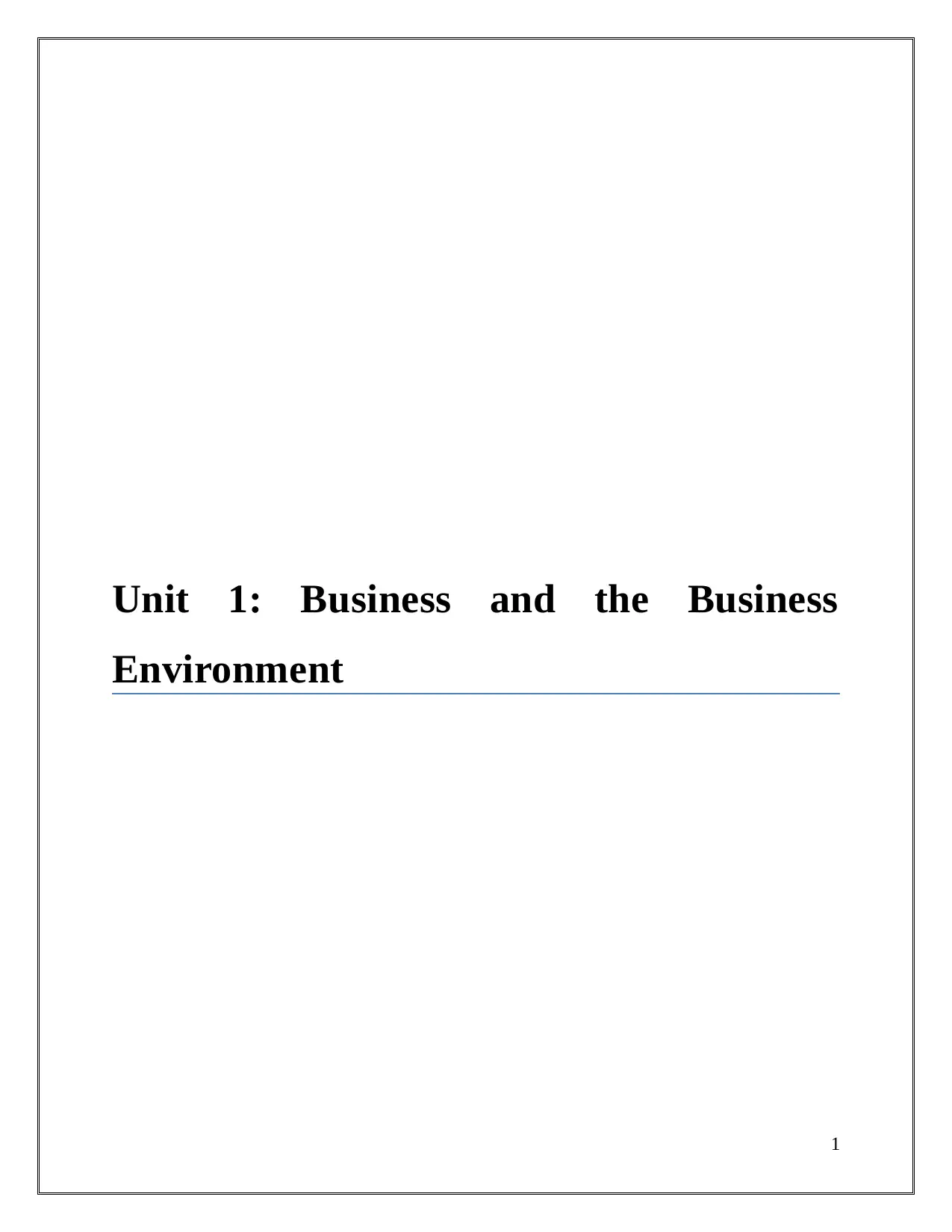
Unit 1: Business and the Business
Environment
1
Environment
1
Paraphrase This Document
Need a fresh take? Get an instant paraphrase of this document with our AI Paraphraser
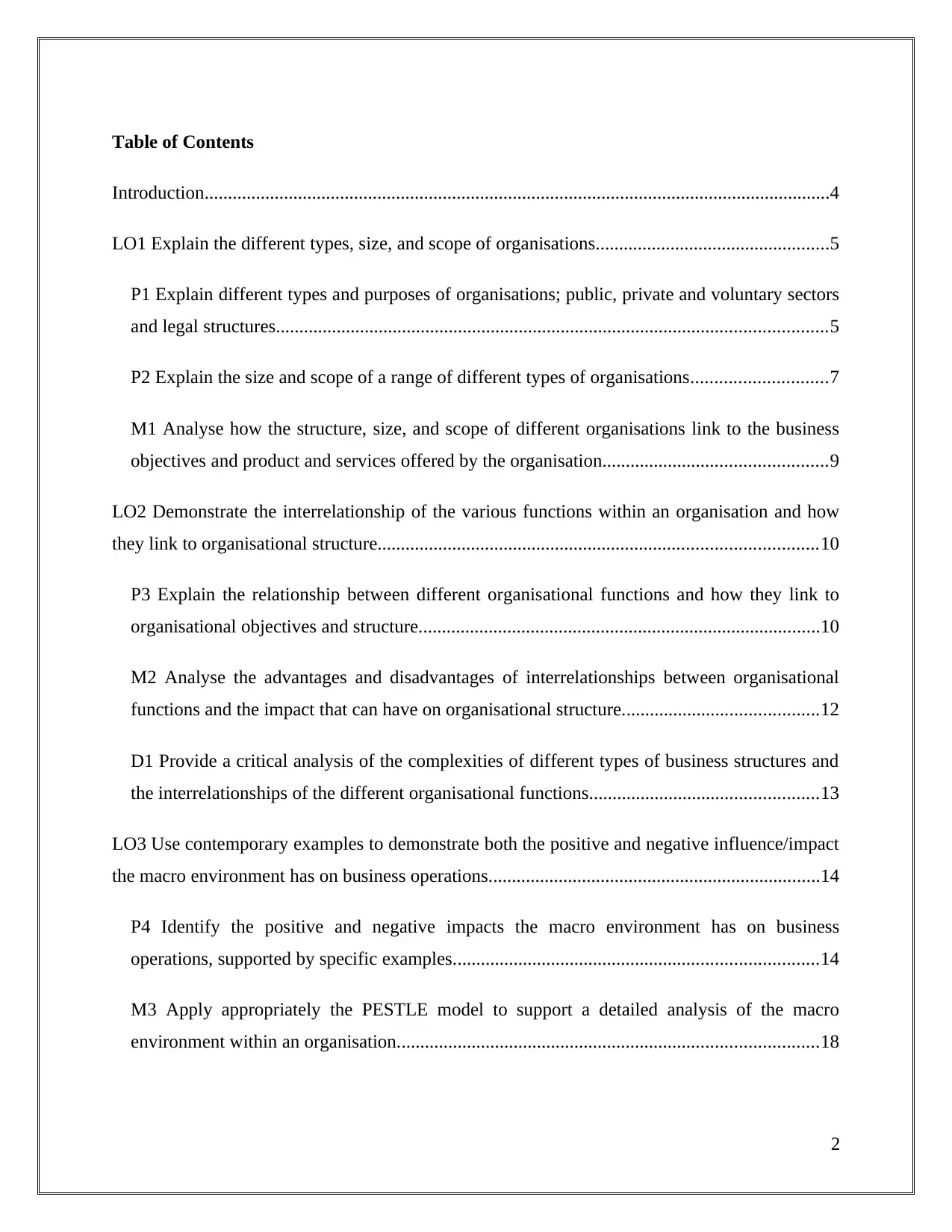
Table of Contents
Introduction......................................................................................................................................4
LO1 Explain the different types, size, and scope of organisations..................................................5
P1 Explain different types and purposes of organisations; public, private and voluntary sectors
and legal structures......................................................................................................................5
P2 Explain the size and scope of a range of different types of organisations.............................7
M1 Analyse how the structure, size, and scope of different organisations link to the business
objectives and product and services offered by the organisation................................................9
LO2 Demonstrate the interrelationship of the various functions within an organisation and how
they link to organisational structure..............................................................................................10
P3 Explain the relationship between different organisational functions and how they link to
organisational objectives and structure......................................................................................10
M2 Analyse the advantages and disadvantages of interrelationships between organisational
functions and the impact that can have on organisational structure..........................................12
D1 Provide a critical analysis of the complexities of different types of business structures and
the interrelationships of the different organisational functions.................................................13
LO3 Use contemporary examples to demonstrate both the positive and negative influence/impact
the macro environment has on business operations.......................................................................14
P4 Identify the positive and negative impacts the macro environment has on business
operations, supported by specific examples..............................................................................14
M3 Apply appropriately the PESTLE model to support a detailed analysis of the macro
environment within an organisation..........................................................................................18
2
Introduction......................................................................................................................................4
LO1 Explain the different types, size, and scope of organisations..................................................5
P1 Explain different types and purposes of organisations; public, private and voluntary sectors
and legal structures......................................................................................................................5
P2 Explain the size and scope of a range of different types of organisations.............................7
M1 Analyse how the structure, size, and scope of different organisations link to the business
objectives and product and services offered by the organisation................................................9
LO2 Demonstrate the interrelationship of the various functions within an organisation and how
they link to organisational structure..............................................................................................10
P3 Explain the relationship between different organisational functions and how they link to
organisational objectives and structure......................................................................................10
M2 Analyse the advantages and disadvantages of interrelationships between organisational
functions and the impact that can have on organisational structure..........................................12
D1 Provide a critical analysis of the complexities of different types of business structures and
the interrelationships of the different organisational functions.................................................13
LO3 Use contemporary examples to demonstrate both the positive and negative influence/impact
the macro environment has on business operations.......................................................................14
P4 Identify the positive and negative impacts the macro environment has on business
operations, supported by specific examples..............................................................................14
M3 Apply appropriately the PESTLE model to support a detailed analysis of the macro
environment within an organisation..........................................................................................18
2
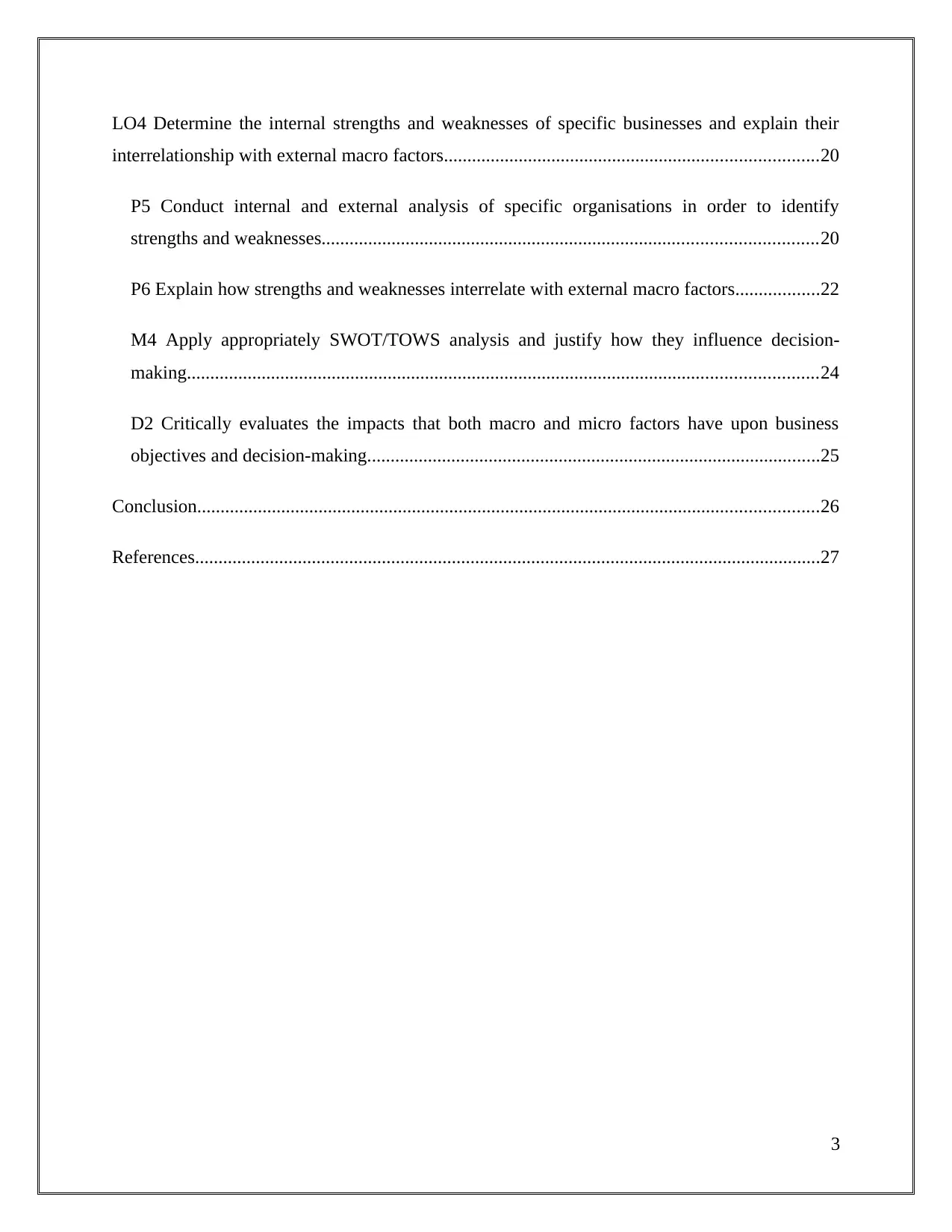
LO4 Determine the internal strengths and weaknesses of specific businesses and explain their
interrelationship with external macro factors................................................................................20
P5 Conduct internal and external analysis of specific organisations in order to identify
strengths and weaknesses..........................................................................................................20
P6 Explain how strengths and weaknesses interrelate with external macro factors..................22
M4 Apply appropriately SWOT/TOWS analysis and justify how they influence decision-
making.......................................................................................................................................24
D2 Critically evaluates the impacts that both macro and micro factors have upon business
objectives and decision-making.................................................................................................25
Conclusion.....................................................................................................................................26
References......................................................................................................................................27
3
interrelationship with external macro factors................................................................................20
P5 Conduct internal and external analysis of specific organisations in order to identify
strengths and weaknesses..........................................................................................................20
P6 Explain how strengths and weaknesses interrelate with external macro factors..................22
M4 Apply appropriately SWOT/TOWS analysis and justify how they influence decision-
making.......................................................................................................................................24
D2 Critically evaluates the impacts that both macro and micro factors have upon business
objectives and decision-making.................................................................................................25
Conclusion.....................................................................................................................................26
References......................................................................................................................................27
3
⊘ This is a preview!⊘
Do you want full access?
Subscribe today to unlock all pages.

Trusted by 1+ million students worldwide
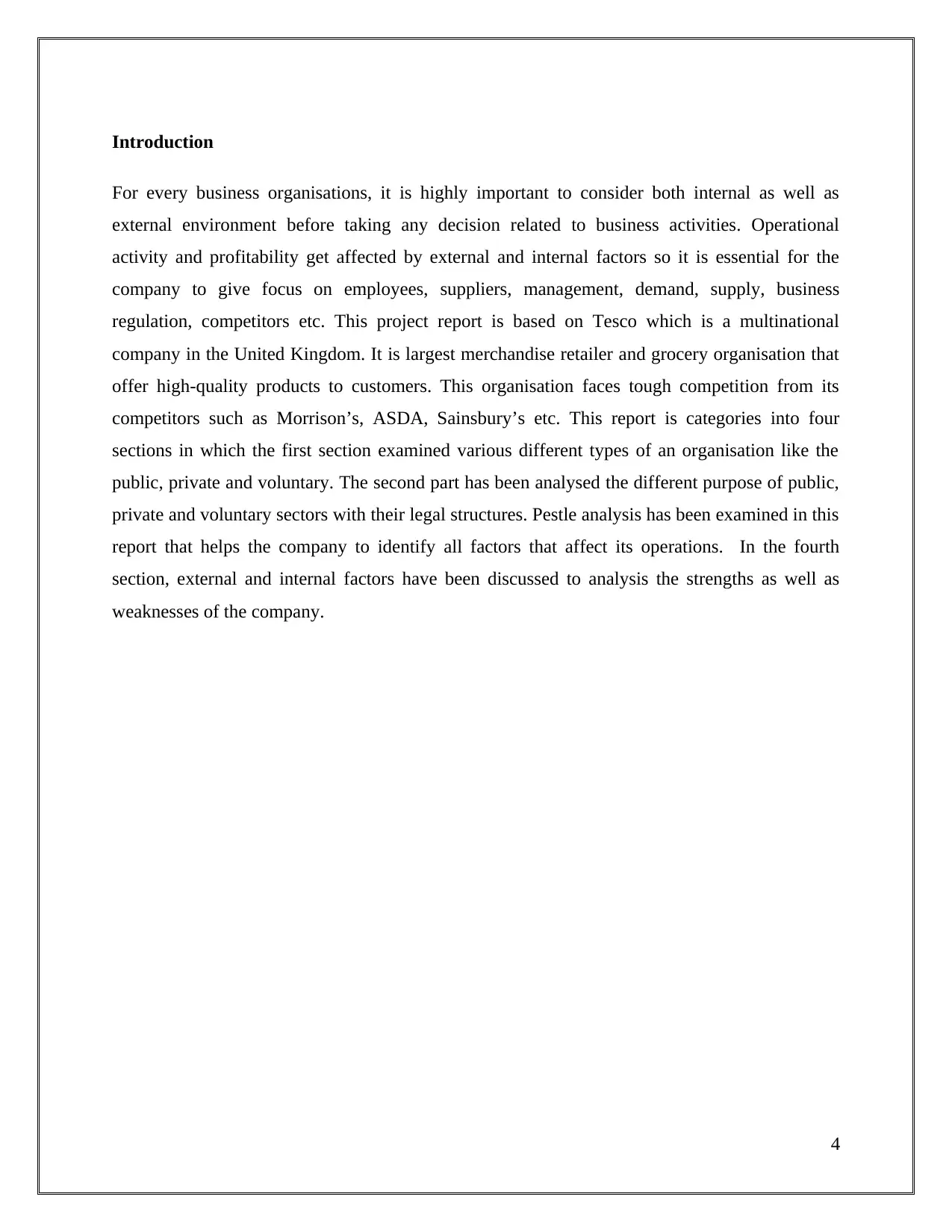
Introduction
For every business organisations, it is highly important to consider both internal as well as
external environment before taking any decision related to business activities. Operational
activity and profitability get affected by external and internal factors so it is essential for the
company to give focus on employees, suppliers, management, demand, supply, business
regulation, competitors etc. This project report is based on Tesco which is a multinational
company in the United Kingdom. It is largest merchandise retailer and grocery organisation that
offer high-quality products to customers. This organisation faces tough competition from its
competitors such as Morrison’s, ASDA, Sainsbury’s etc. This report is categories into four
sections in which the first section examined various different types of an organisation like the
public, private and voluntary. The second part has been analysed the different purpose of public,
private and voluntary sectors with their legal structures. Pestle analysis has been examined in this
report that helps the company to identify all factors that affect its operations. In the fourth
section, external and internal factors have been discussed to analysis the strengths as well as
weaknesses of the company.
4
For every business organisations, it is highly important to consider both internal as well as
external environment before taking any decision related to business activities. Operational
activity and profitability get affected by external and internal factors so it is essential for the
company to give focus on employees, suppliers, management, demand, supply, business
regulation, competitors etc. This project report is based on Tesco which is a multinational
company in the United Kingdom. It is largest merchandise retailer and grocery organisation that
offer high-quality products to customers. This organisation faces tough competition from its
competitors such as Morrison’s, ASDA, Sainsbury’s etc. This report is categories into four
sections in which the first section examined various different types of an organisation like the
public, private and voluntary. The second part has been analysed the different purpose of public,
private and voluntary sectors with their legal structures. Pestle analysis has been examined in this
report that helps the company to identify all factors that affect its operations. In the fourth
section, external and internal factors have been discussed to analysis the strengths as well as
weaknesses of the company.
4
Paraphrase This Document
Need a fresh take? Get an instant paraphrase of this document with our AI Paraphraser
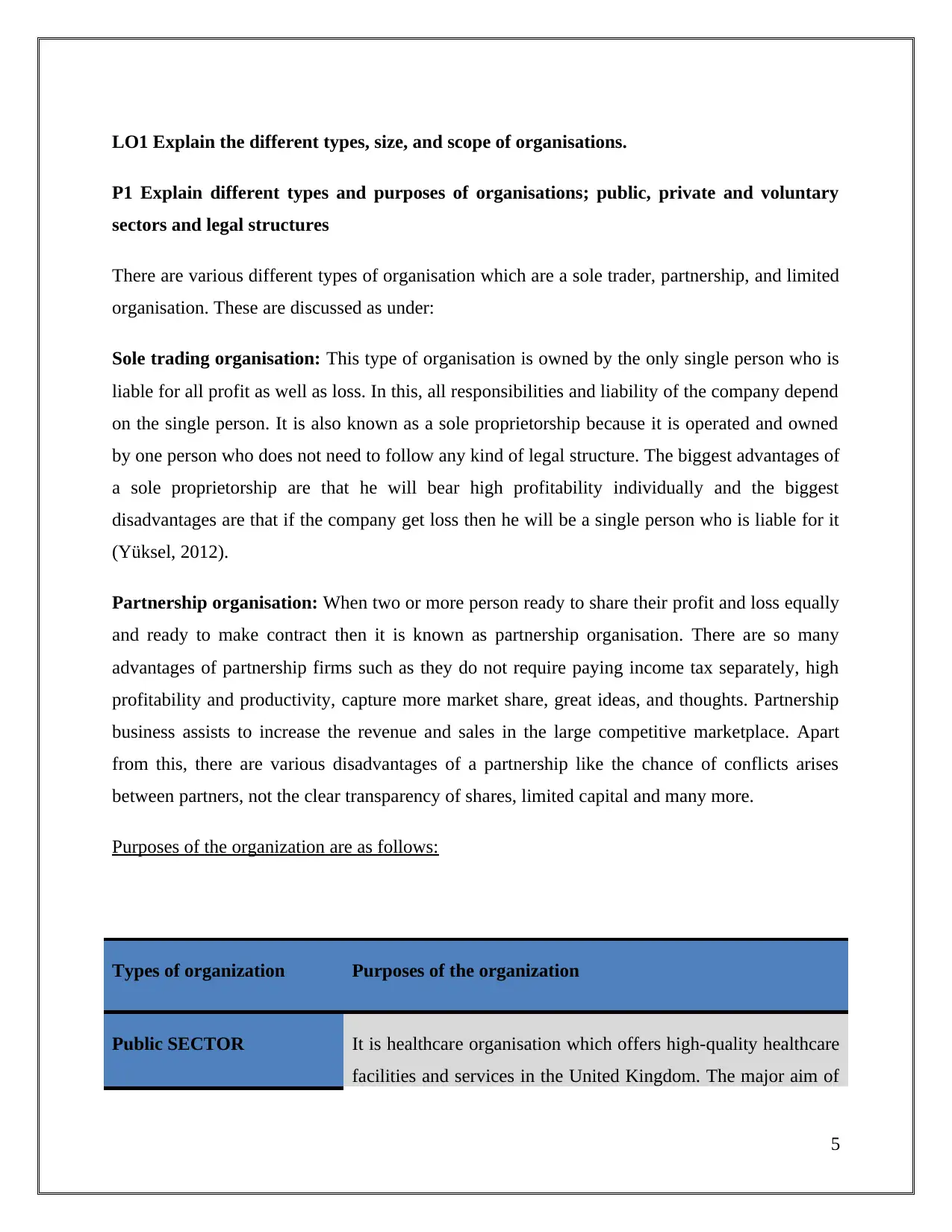
LO1 Explain the different types, size, and scope of organisations.
P1 Explain different types and purposes of organisations; public, private and voluntary
sectors and legal structures
There are various different types of organisation which are a sole trader, partnership, and limited
organisation. These are discussed as under:
Sole trading organisation: This type of organisation is owned by the only single person who is
liable for all profit as well as loss. In this, all responsibilities and liability of the company depend
on the single person. It is also known as a sole proprietorship because it is operated and owned
by one person who does not need to follow any kind of legal structure. The biggest advantages of
a sole proprietorship are that he will bear high profitability individually and the biggest
disadvantages are that if the company get loss then he will be a single person who is liable for it
(Yüksel, 2012).
Partnership organisation: When two or more person ready to share their profit and loss equally
and ready to make contract then it is known as partnership organisation. There are so many
advantages of partnership firms such as they do not require paying income tax separately, high
profitability and productivity, capture more market share, great ideas, and thoughts. Partnership
business assists to increase the revenue and sales in the large competitive marketplace. Apart
from this, there are various disadvantages of a partnership like the chance of conflicts arises
between partners, not the clear transparency of shares, limited capital and many more.
Purposes of the organization are as follows:
Types of organization Purposes of the organization
Public SECTOR It is healthcare organisation which offers high-quality healthcare
facilities and services in the United Kingdom. The major aim of
5
P1 Explain different types and purposes of organisations; public, private and voluntary
sectors and legal structures
There are various different types of organisation which are a sole trader, partnership, and limited
organisation. These are discussed as under:
Sole trading organisation: This type of organisation is owned by the only single person who is
liable for all profit as well as loss. In this, all responsibilities and liability of the company depend
on the single person. It is also known as a sole proprietorship because it is operated and owned
by one person who does not need to follow any kind of legal structure. The biggest advantages of
a sole proprietorship are that he will bear high profitability individually and the biggest
disadvantages are that if the company get loss then he will be a single person who is liable for it
(Yüksel, 2012).
Partnership organisation: When two or more person ready to share their profit and loss equally
and ready to make contract then it is known as partnership organisation. There are so many
advantages of partnership firms such as they do not require paying income tax separately, high
profitability and productivity, capture more market share, great ideas, and thoughts. Partnership
business assists to increase the revenue and sales in the large competitive marketplace. Apart
from this, there are various disadvantages of a partnership like the chance of conflicts arises
between partners, not the clear transparency of shares, limited capital and many more.
Purposes of the organization are as follows:
Types of organization Purposes of the organization
Public SECTOR It is healthcare organisation which offers high-quality healthcare
facilities and services in the United Kingdom. The major aim of
5
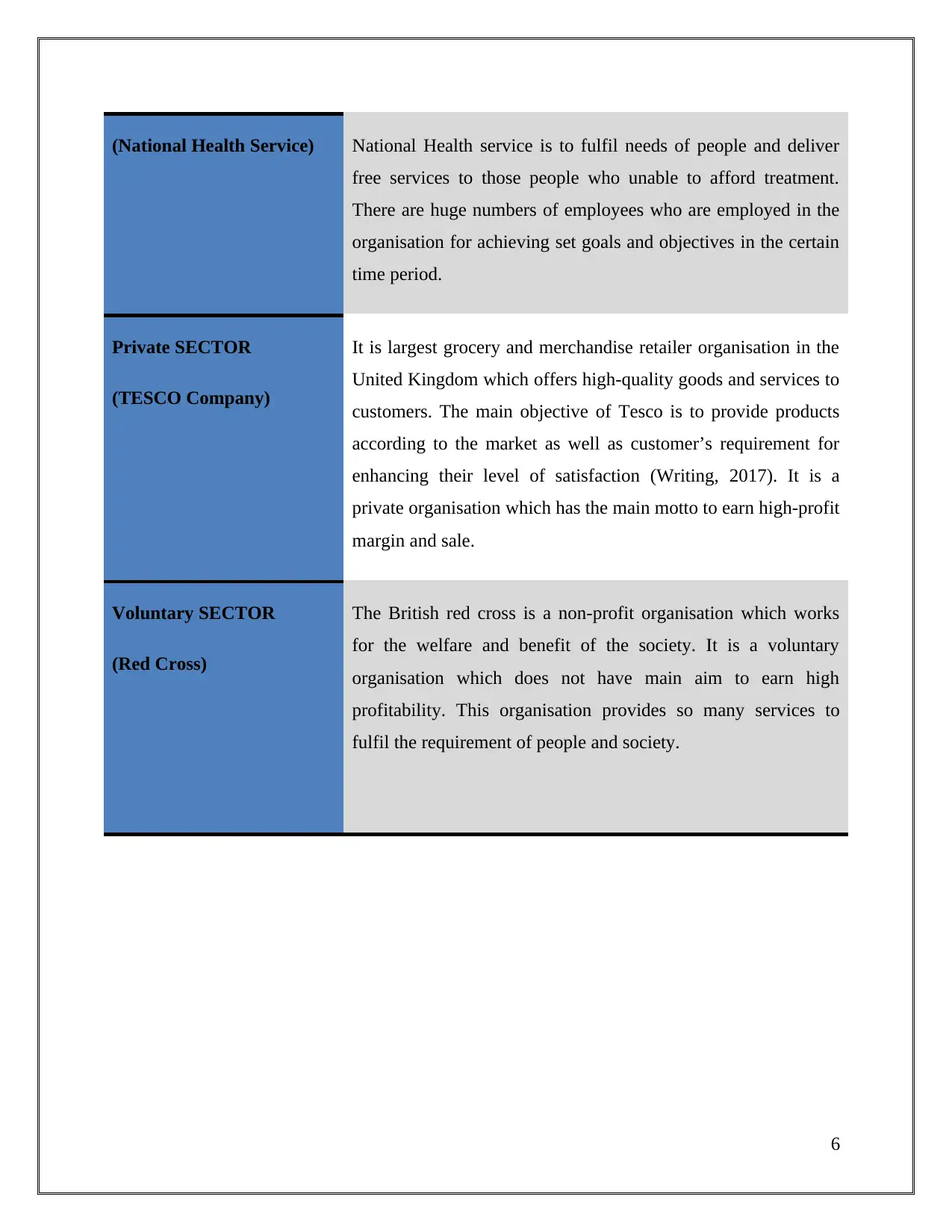
(National Health Service) National Health service is to fulfil needs of people and deliver
free services to those people who unable to afford treatment.
There are huge numbers of employees who are employed in the
organisation for achieving set goals and objectives in the certain
time period.
Private SECTOR
(TESCO Company)
It is largest grocery and merchandise retailer organisation in the
United Kingdom which offers high-quality goods and services to
customers. The main objective of Tesco is to provide products
according to the market as well as customer’s requirement for
enhancing their level of satisfaction (Writing, 2017). It is a
private organisation which has the main motto to earn high-profit
margin and sale.
Voluntary SECTOR
(Red Cross)
The British red cross is a non-profit organisation which works
for the welfare and benefit of the society. It is a voluntary
organisation which does not have main aim to earn high
profitability. This organisation provides so many services to
fulfil the requirement of people and society.
6
free services to those people who unable to afford treatment.
There are huge numbers of employees who are employed in the
organisation for achieving set goals and objectives in the certain
time period.
Private SECTOR
(TESCO Company)
It is largest grocery and merchandise retailer organisation in the
United Kingdom which offers high-quality goods and services to
customers. The main objective of Tesco is to provide products
according to the market as well as customer’s requirement for
enhancing their level of satisfaction (Writing, 2017). It is a
private organisation which has the main motto to earn high-profit
margin and sale.
Voluntary SECTOR
(Red Cross)
The British red cross is a non-profit organisation which works
for the welfare and benefit of the society. It is a voluntary
organisation which does not have main aim to earn high
profitability. This organisation provides so many services to
fulfil the requirement of people and society.
6
⊘ This is a preview!⊘
Do you want full access?
Subscribe today to unlock all pages.

Trusted by 1+ million students worldwide
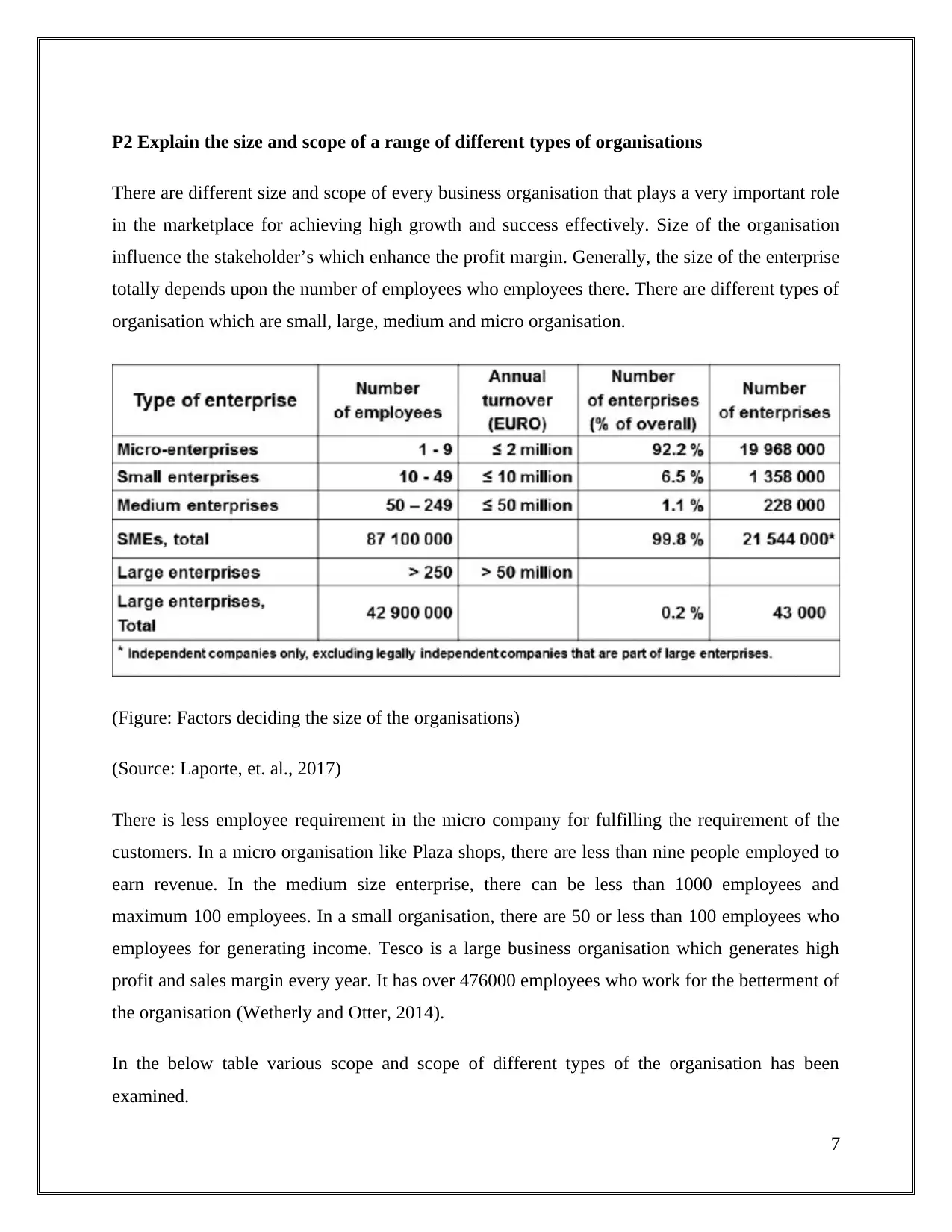
P2 Explain the size and scope of a range of different types of organisations
There are different size and scope of every business organisation that plays a very important role
in the marketplace for achieving high growth and success effectively. Size of the organisation
influence the stakeholder’s which enhance the profit margin. Generally, the size of the enterprise
totally depends upon the number of employees who employees there. There are different types of
organisation which are small, large, medium and micro organisation.
(Figure: Factors deciding the size of the organisations)
(Source: Laporte, et. al., 2017)
There is less employee requirement in the micro company for fulfilling the requirement of the
customers. In a micro organisation like Plaza shops, there are less than nine people employed to
earn revenue. In the medium size enterprise, there can be less than 1000 employees and
maximum 100 employees. In a small organisation, there are 50 or less than 100 employees who
employees for generating income. Tesco is a large business organisation which generates high
profit and sales margin every year. It has over 476000 employees who work for the betterment of
the organisation (Wetherly and Otter, 2014).
In the below table various scope and scope of different types of the organisation has been
examined.
7
There are different size and scope of every business organisation that plays a very important role
in the marketplace for achieving high growth and success effectively. Size of the organisation
influence the stakeholder’s which enhance the profit margin. Generally, the size of the enterprise
totally depends upon the number of employees who employees there. There are different types of
organisation which are small, large, medium and micro organisation.
(Figure: Factors deciding the size of the organisations)
(Source: Laporte, et. al., 2017)
There is less employee requirement in the micro company for fulfilling the requirement of the
customers. In a micro organisation like Plaza shops, there are less than nine people employed to
earn revenue. In the medium size enterprise, there can be less than 1000 employees and
maximum 100 employees. In a small organisation, there are 50 or less than 100 employees who
employees for generating income. Tesco is a large business organisation which generates high
profit and sales margin every year. It has over 476000 employees who work for the betterment of
the organisation (Wetherly and Otter, 2014).
In the below table various scope and scope of different types of the organisation has been
examined.
7
Paraphrase This Document
Need a fresh take? Get an instant paraphrase of this document with our AI Paraphraser
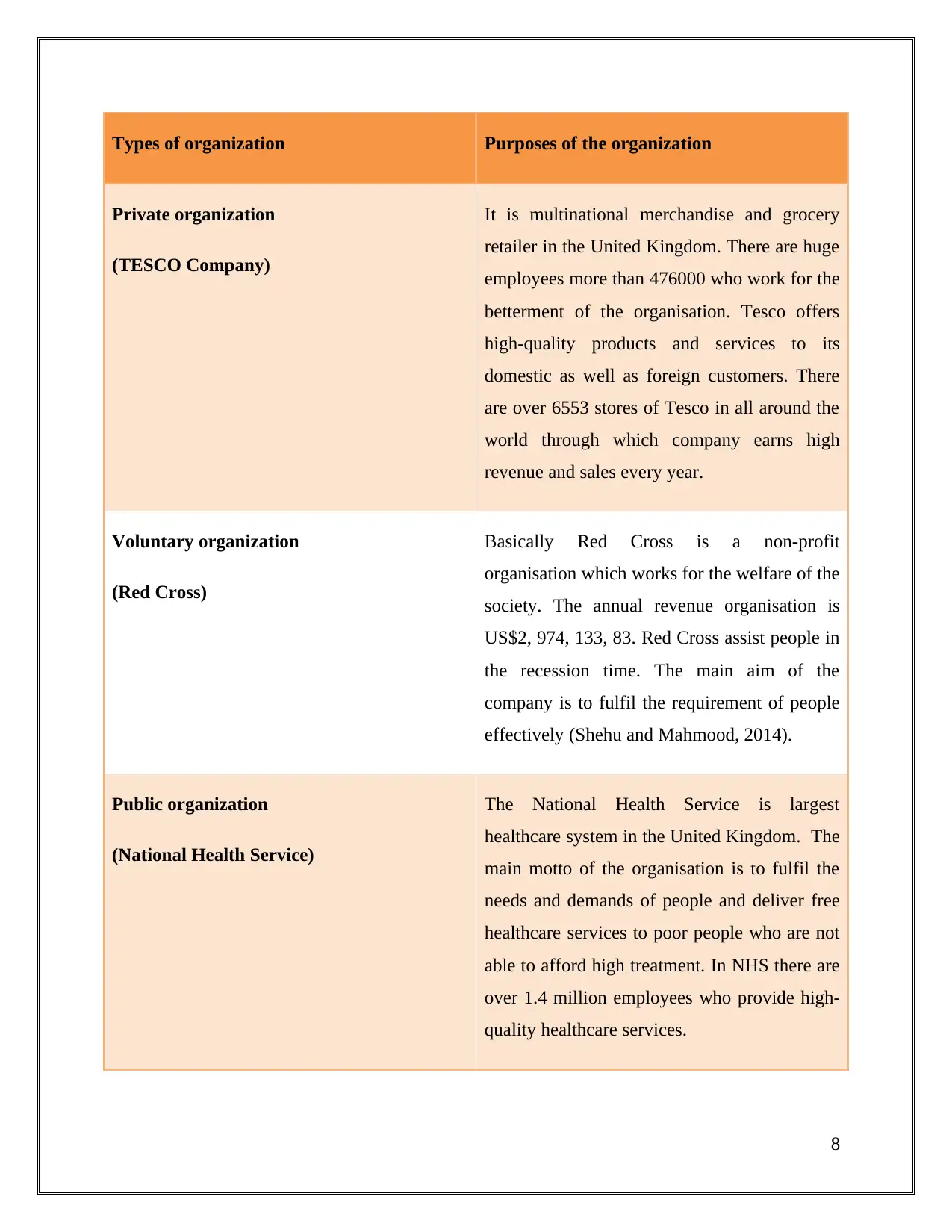
Types of organization Purposes of the organization
Private organization
(TESCO Company)
It is multinational merchandise and grocery
retailer in the United Kingdom. There are huge
employees more than 476000 who work for the
betterment of the organisation. Tesco offers
high-quality products and services to its
domestic as well as foreign customers. There
are over 6553 stores of Tesco in all around the
world through which company earns high
revenue and sales every year.
Voluntary organization
(Red Cross)
Basically Red Cross is a non-profit
organisation which works for the welfare of the
society. The annual revenue organisation is
US$2, 974, 133, 83. Red Cross assist people in
the recession time. The main aim of the
company is to fulfil the requirement of people
effectively (Shehu and Mahmood, 2014).
Public organization
(National Health Service)
The National Health Service is largest
healthcare system in the United Kingdom. The
main motto of the organisation is to fulfil the
needs and demands of people and deliver free
healthcare services to poor people who are not
able to afford high treatment. In NHS there are
over 1.4 million employees who provide high-
quality healthcare services.
8
Private organization
(TESCO Company)
It is multinational merchandise and grocery
retailer in the United Kingdom. There are huge
employees more than 476000 who work for the
betterment of the organisation. Tesco offers
high-quality products and services to its
domestic as well as foreign customers. There
are over 6553 stores of Tesco in all around the
world through which company earns high
revenue and sales every year.
Voluntary organization
(Red Cross)
Basically Red Cross is a non-profit
organisation which works for the welfare of the
society. The annual revenue organisation is
US$2, 974, 133, 83. Red Cross assist people in
the recession time. The main aim of the
company is to fulfil the requirement of people
effectively (Shehu and Mahmood, 2014).
Public organization
(National Health Service)
The National Health Service is largest
healthcare system in the United Kingdom. The
main motto of the organisation is to fulfil the
needs and demands of people and deliver free
healthcare services to poor people who are not
able to afford high treatment. In NHS there are
over 1.4 million employees who provide high-
quality healthcare services.
8
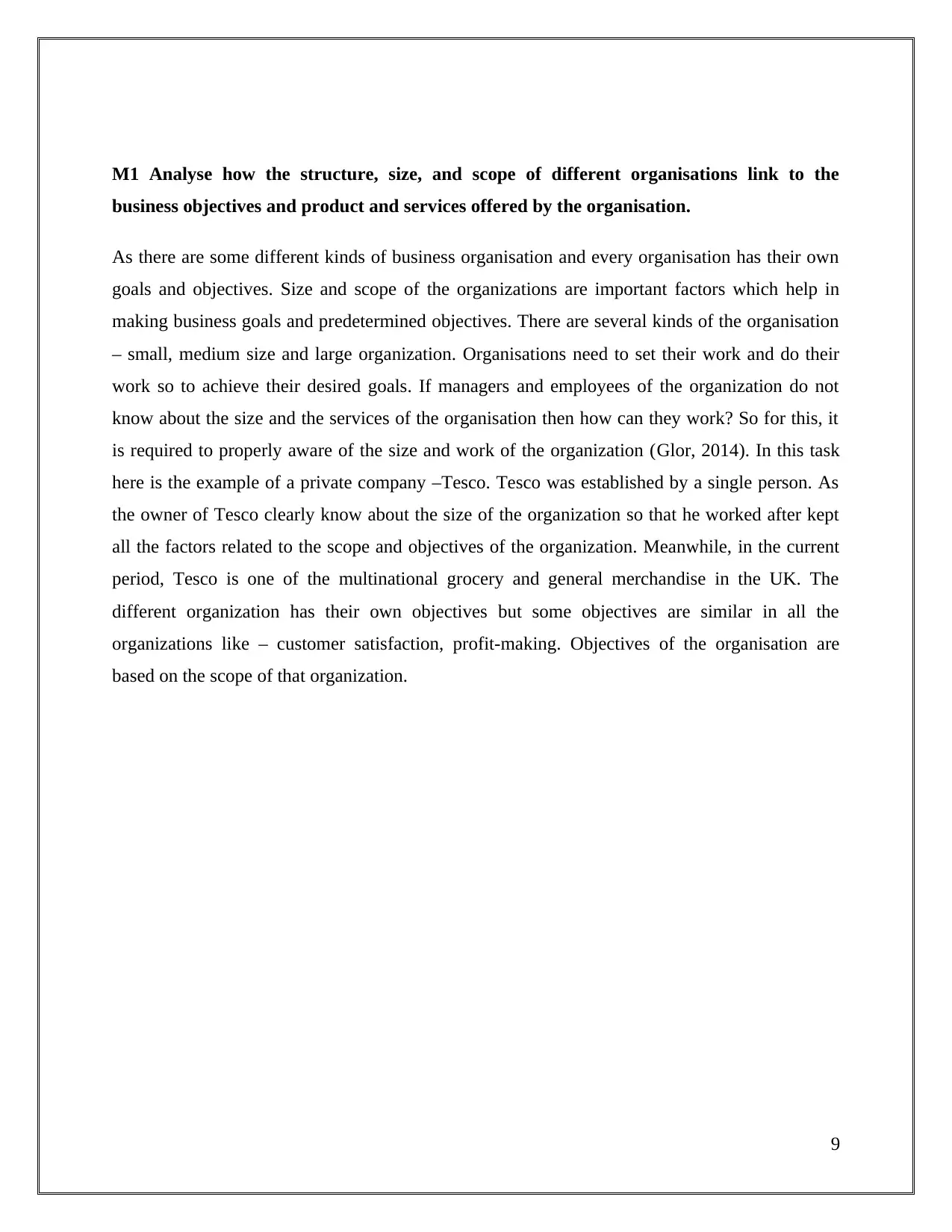
M1 Analyse how the structure, size, and scope of different organisations link to the
business objectives and product and services offered by the organisation.
As there are some different kinds of business organisation and every organisation has their own
goals and objectives. Size and scope of the organizations are important factors which help in
making business goals and predetermined objectives. There are several kinds of the organisation
– small, medium size and large organization. Organisations need to set their work and do their
work so to achieve their desired goals. If managers and employees of the organization do not
know about the size and the services of the organisation then how can they work? So for this, it
is required to properly aware of the size and work of the organization (Glor, 2014). In this task
here is the example of a private company –Tesco. Tesco was established by a single person. As
the owner of Tesco clearly know about the size of the organization so that he worked after kept
all the factors related to the scope and objectives of the organization. Meanwhile, in the current
period, Tesco is one of the multinational grocery and general merchandise in the UK. The
different organization has their own objectives but some objectives are similar in all the
organizations like – customer satisfaction, profit-making. Objectives of the organisation are
based on the scope of that organization.
9
business objectives and product and services offered by the organisation.
As there are some different kinds of business organisation and every organisation has their own
goals and objectives. Size and scope of the organizations are important factors which help in
making business goals and predetermined objectives. There are several kinds of the organisation
– small, medium size and large organization. Organisations need to set their work and do their
work so to achieve their desired goals. If managers and employees of the organization do not
know about the size and the services of the organisation then how can they work? So for this, it
is required to properly aware of the size and work of the organization (Glor, 2014). In this task
here is the example of a private company –Tesco. Tesco was established by a single person. As
the owner of Tesco clearly know about the size of the organization so that he worked after kept
all the factors related to the scope and objectives of the organization. Meanwhile, in the current
period, Tesco is one of the multinational grocery and general merchandise in the UK. The
different organization has their own objectives but some objectives are similar in all the
organizations like – customer satisfaction, profit-making. Objectives of the organisation are
based on the scope of that organization.
9
⊘ This is a preview!⊘
Do you want full access?
Subscribe today to unlock all pages.

Trusted by 1+ million students worldwide
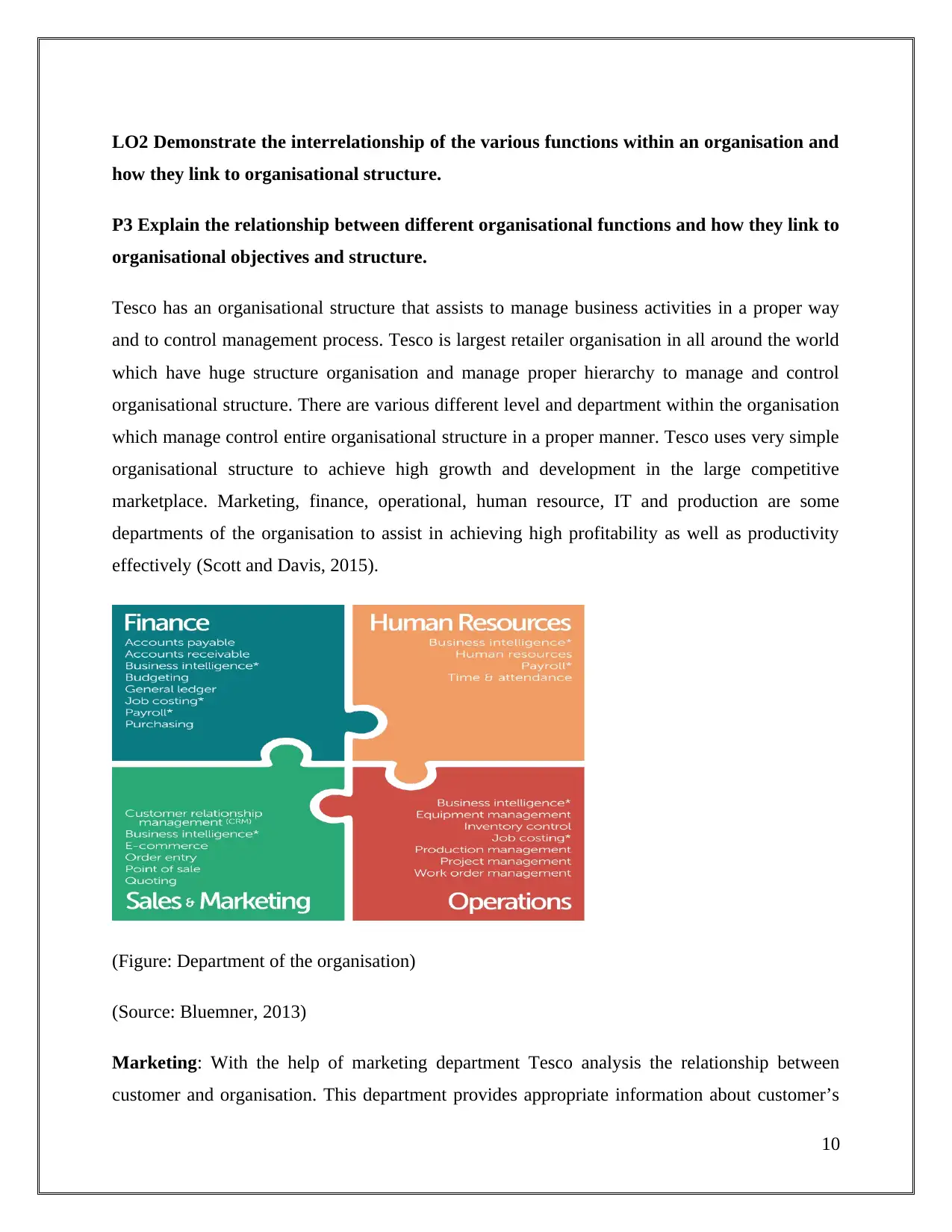
LO2 Demonstrate the interrelationship of the various functions within an organisation and
how they link to organisational structure.
P3 Explain the relationship between different organisational functions and how they link to
organisational objectives and structure.
Tesco has an organisational structure that assists to manage business activities in a proper way
and to control management process. Tesco is largest retailer organisation in all around the world
which have huge structure organisation and manage proper hierarchy to manage and control
organisational structure. There are various different level and department within the organisation
which manage control entire organisational structure in a proper manner. Tesco uses very simple
organisational structure to achieve high growth and development in the large competitive
marketplace. Marketing, finance, operational, human resource, IT and production are some
departments of the organisation to assist in achieving high profitability as well as productivity
effectively (Scott and Davis, 2015).
(Figure: Department of the organisation)
(Source: Bluemner, 2013)
Marketing: With the help of marketing department Tesco analysis the relationship between
customer and organisation. This department provides appropriate information about customer’s
10
how they link to organisational structure.
P3 Explain the relationship between different organisational functions and how they link to
organisational objectives and structure.
Tesco has an organisational structure that assists to manage business activities in a proper way
and to control management process. Tesco is largest retailer organisation in all around the world
which have huge structure organisation and manage proper hierarchy to manage and control
organisational structure. There are various different level and department within the organisation
which manage control entire organisational structure in a proper manner. Tesco uses very simple
organisational structure to achieve high growth and development in the large competitive
marketplace. Marketing, finance, operational, human resource, IT and production are some
departments of the organisation to assist in achieving high profitability as well as productivity
effectively (Scott and Davis, 2015).
(Figure: Department of the organisation)
(Source: Bluemner, 2013)
Marketing: With the help of marketing department Tesco analysis the relationship between
customer and organisation. This department provides appropriate information about customer’s
10
Paraphrase This Document
Need a fresh take? Get an instant paraphrase of this document with our AI Paraphraser
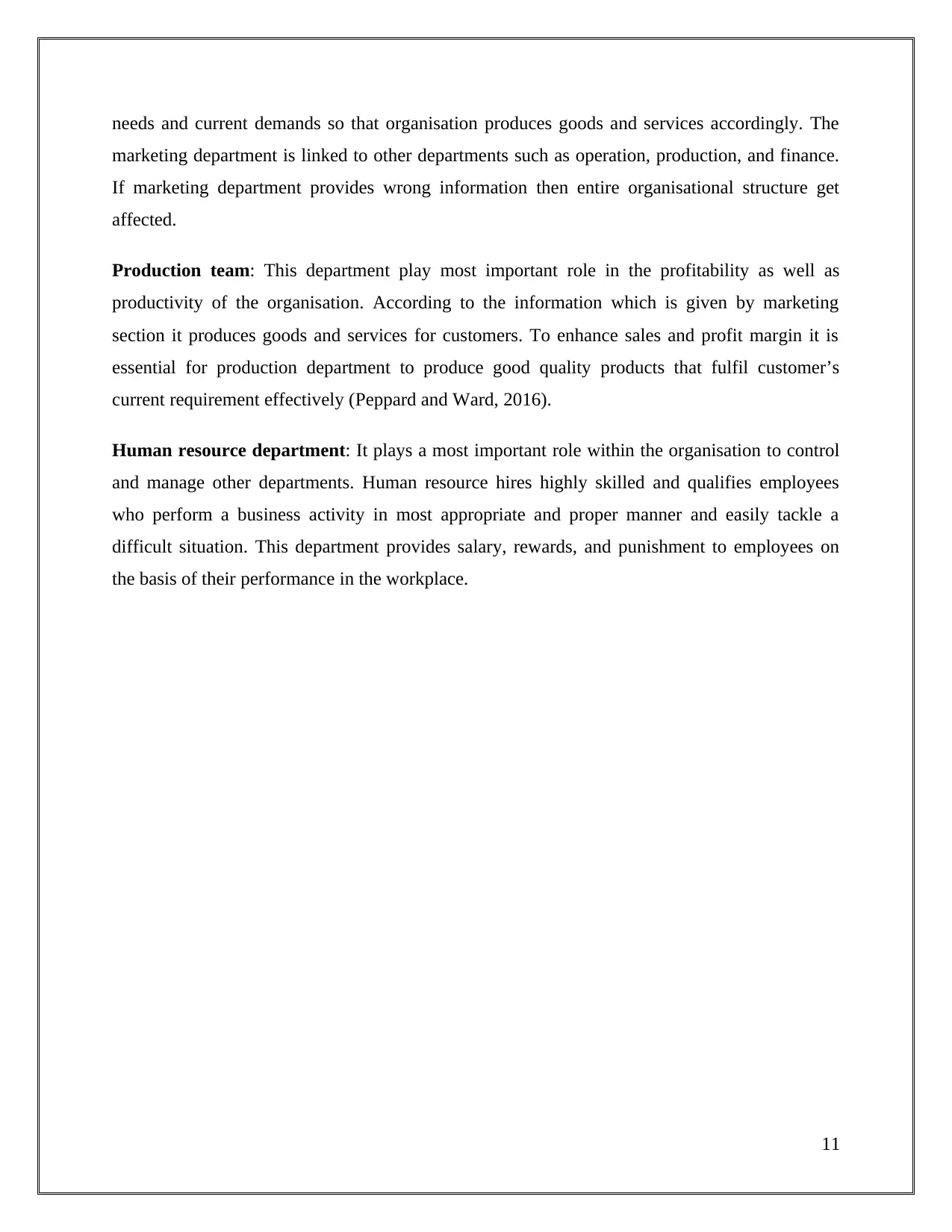
needs and current demands so that organisation produces goods and services accordingly. The
marketing department is linked to other departments such as operation, production, and finance.
If marketing department provides wrong information then entire organisational structure get
affected.
Production team: This department play most important role in the profitability as well as
productivity of the organisation. According to the information which is given by marketing
section it produces goods and services for customers. To enhance sales and profit margin it is
essential for production department to produce good quality products that fulfil customer’s
current requirement effectively (Peppard and Ward, 2016).
Human resource department: It plays a most important role within the organisation to control
and manage other departments. Human resource hires highly skilled and qualifies employees
who perform a business activity in most appropriate and proper manner and easily tackle a
difficult situation. This department provides salary, rewards, and punishment to employees on
the basis of their performance in the workplace.
11
marketing department is linked to other departments such as operation, production, and finance.
If marketing department provides wrong information then entire organisational structure get
affected.
Production team: This department play most important role in the profitability as well as
productivity of the organisation. According to the information which is given by marketing
section it produces goods and services for customers. To enhance sales and profit margin it is
essential for production department to produce good quality products that fulfil customer’s
current requirement effectively (Peppard and Ward, 2016).
Human resource department: It plays a most important role within the organisation to control
and manage other departments. Human resource hires highly skilled and qualifies employees
who perform a business activity in most appropriate and proper manner and easily tackle a
difficult situation. This department provides salary, rewards, and punishment to employees on
the basis of their performance in the workplace.
11
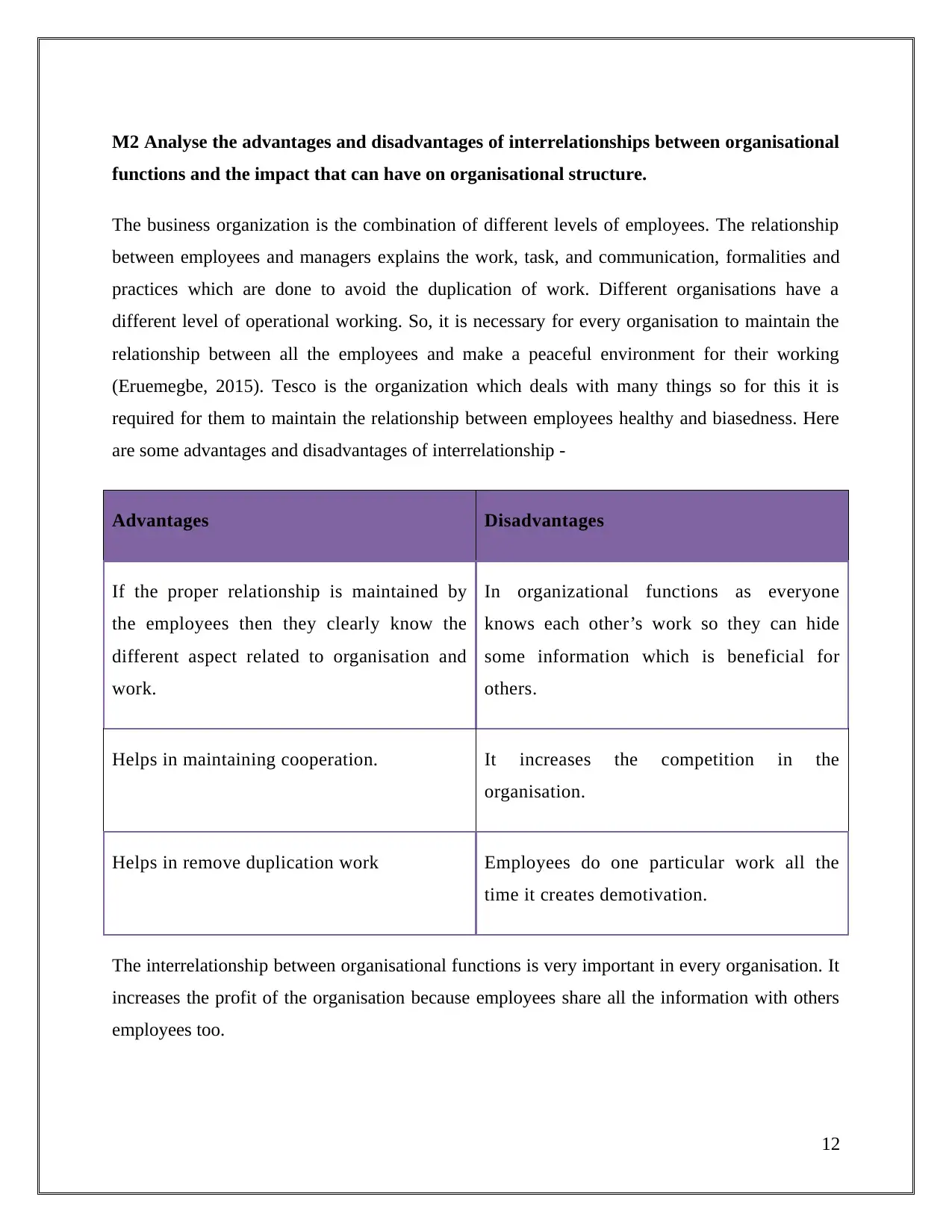
M2 Analyse the advantages and disadvantages of interrelationships between organisational
functions and the impact that can have on organisational structure.
The business organization is the combination of different levels of employees. The relationship
between employees and managers explains the work, task, and communication, formalities and
practices which are done to avoid the duplication of work. Different organisations have a
different level of operational working. So, it is necessary for every organisation to maintain the
relationship between all the employees and make a peaceful environment for their working
(Eruemegbe, 2015). Tesco is the organization which deals with many things so for this it is
required for them to maintain the relationship between employees healthy and biasedness. Here
are some advantages and disadvantages of interrelationship -
Advantages Disadvantages
If the proper relationship is maintained by
the employees then they clearly know the
different aspect related to organisation and
work.
In organizational functions as everyone
knows each other’s work so they can hide
some information which is beneficial for
others.
Helps in maintaining cooperation. It increases the competition in the
organisation.
Helps in remove duplication work Employees do one particular work all the
time it creates demotivation.
The interrelationship between organisational functions is very important in every organisation. It
increases the profit of the organisation because employees share all the information with others
employees too.
12
functions and the impact that can have on organisational structure.
The business organization is the combination of different levels of employees. The relationship
between employees and managers explains the work, task, and communication, formalities and
practices which are done to avoid the duplication of work. Different organisations have a
different level of operational working. So, it is necessary for every organisation to maintain the
relationship between all the employees and make a peaceful environment for their working
(Eruemegbe, 2015). Tesco is the organization which deals with many things so for this it is
required for them to maintain the relationship between employees healthy and biasedness. Here
are some advantages and disadvantages of interrelationship -
Advantages Disadvantages
If the proper relationship is maintained by
the employees then they clearly know the
different aspect related to organisation and
work.
In organizational functions as everyone
knows each other’s work so they can hide
some information which is beneficial for
others.
Helps in maintaining cooperation. It increases the competition in the
organisation.
Helps in remove duplication work Employees do one particular work all the
time it creates demotivation.
The interrelationship between organisational functions is very important in every organisation. It
increases the profit of the organisation because employees share all the information with others
employees too.
12
⊘ This is a preview!⊘
Do you want full access?
Subscribe today to unlock all pages.

Trusted by 1+ million students worldwide
1 out of 28
Related Documents
Your All-in-One AI-Powered Toolkit for Academic Success.
+13062052269
info@desklib.com
Available 24*7 on WhatsApp / Email
![[object Object]](/_next/static/media/star-bottom.7253800d.svg)
Unlock your academic potential
Copyright © 2020–2025 A2Z Services. All Rights Reserved. Developed and managed by ZUCOL.




